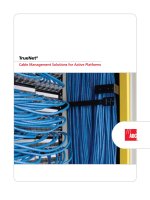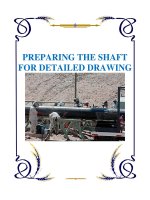Tài liệu Q&A Session for Advanced Ball Screws 201: Troubleshooting for Design Engineers docx
Bạn đang xem bản rút gọn của tài liệu. Xem và tải ngay bản đầy đủ của tài liệu tại đây (88.4 KB, 7 trang )
Q&A Session for Advanced Ball Screws 201:
Troubleshooting for Design Engineers
Topic: Noise
Q: Is there a way to predict/calculate noise on a ball screw?
A: No, there is no way to calculate the noise of a ball screw. There are ways to minimize the
noise of an application though. Larger ball screws utilize larger ball bearings and are therefore
inherently noisier. External return systems are also inherently noisier than internal return system.
The use of spacer balls can reduce the noise of a ball nut. The selection and proper application
of grease can also reduce the overall noise level. Minimizing or eliminating back lash can also
reduce noise in an assembly.
Q: Using a ball screw with a stepper motor driven system, can noise be reduced with a
preloaded bearing?
A: Yes, a preloaded ball nut will be quieter than a ball nut with back lash. A preloaded ball nut
adds complexity, cost, and increased torque into an assembly and therefore may not be a good
solution if noise is the only consideration.
Topic: Lubrication
Q: What lubricating agent should be used?
A: The selection of the proper lubricant is dependent on the application, environment, and
maintenance interval. Thomson offers a general purpose lubricant for ball screws in our TriGel
450R.
Q: How to define the right amount of lube to inject in a ball nut?
A: As a general rule, the ball screw should be “wet” at all times and a ball nut should be filled until
grease escapes from the ends of the nut. High speed applications will require less grease
(approximately 30% fill) or an oil lubricant.
Q: With oil, how do you determine required amount of lubrication for the ball nut?
A: A continuous drip should be used for oil lubrication.
Q: One question about lubrication - how do you clean these prior to re-lubrication if you
suspect contamination of the existing lubricant?
A: A industrial degreaser and rag is sufficient to clean a ball screw. The ball nut must be
removed, disassembled, and all components cleaned if it is suspected that debris or
contaminants are present to prevent premature wear.
Q: Do you offer pre-lubrication on your ball screw products similar to your linear bearing
line?
A: Ball screw components and assemblies are shipped with a rust preventative only unless
otherwise specified by a customer. Custom lubricants are available upon request.
Q: What lubrication would be recommended in a waste water treatment plant?
A: The selection of the proper lubricant is dependent on the application, environment, and
maintenance interval. It is impossible to select a lubricant based upon the industry without
knowing the other specifications.
Q: Do you have a particular grease recommendation for a micro motion or "dithering"
application?
A: A high viscosity and load bearing grease would be recommended. (i.e. Mobil Polyrex EP2 or
equivalent)
Q: What do you recommend for seals or wipers to keep out contaminates? How is
lubrication affected when using seals/wipers?
A: The precision inch series has optional nylon brush style wipers. The precision plus inch series
uses formed nylon wipers. The FineLine metric series and precision plus metric series use
formed Delrin wipers. The NEFF metric series uses formed rubber wipers. A brush style wiper is
good for general purpose applications and will remove debris and offer some grease retention. A
formed wiper will offer improved grease retention. A hard plastic wiper will be better at removing
debris whereas a formed rubber wiper will be better to protect against loose contaminants.
Q: How do you keep oil lube contained? How do you feed it in?
A: Oil must be continuously drip feed into the ball nut or the ball nut may be submerged into an oil
bath. Typical oil application require an oil pump, oil reservoir, and automation system.
Q: What are the best seals to be used in applications of high contamination?
A formed rubber wiper would be the best selection for this type of application.
Q: Can you recommend using dry lubricants in dirty/dusty environment?
A: The choice of lubricants is dependent on the application and environment. Contact the
lubricant supplier for recommendations regarding selection of a lubricant for the specific
application. Contamination of any kind will increase wear and reduce life regardless of lubricant
used.
Q: Are there seals to retain the grease in the ball screw housing?
A: Wipers are available as standard or optional on most ball nuts.
Q: Are Sealeze brushes are adequate?
A: The precision inch series of ball nuts uses brush style wipers that are similar to the Sealeze
brushes and therefore this type of wiper is adequate for certain applications.
Q: Do you have any experience with use of ball screw in an exposed marine environment?
A: Yes, we have over 60 years of ball screw application experience in all types of environments.
Typically exposed marine environments would utilize a stainless steel ball screw or special
coatings to protect against corrosion.
Q: Wiper will not retain grease I have had this happen already.
A: The grease retention capability of a wiper is dependent on the style of wiper. All wipers will
allow some grease to escape and therefore it is necessary to perform periodic maintenance and
lubrication.
Q: Can you present a PHOTO of these nylon wipers and brushes?
Q: Do you offer any materials that are corrosion resistant?
A: Yes, we stock may sizes in stainless steel and can custom fabricate many more. We also can
offer corrosion resistant coatings when specified.
Q: Is there one lubrication for Wisconsin outdoors (hot and cold)?
A: This would be a better question for a lubrication provider. Standard industrial greases do not
have the low end temperature rating that I believe you are looking for. Therefore, a grease with a
lower temperature rating would be required.
Q: Besides wipers, do you offer any type of grease containment system, such as bellows?
A: No, we do not offer bellows but these types of products are commercially available.
Q: What other companies do you typically recommend for bellows or grease containment
systems?
A: There are a number of commercially available bellow suppliers. We currently do not
recommend or use one more than another. Please contact a bellows specialist for correct
product recommendations and then determine the best product for your application.
Q: Are waxy router bearing lubricants which do not attract dust effective on ball screws?
Specific types are Bostic Bearing Lubricant and Boeshield T9.
A: Yes, these types of lubricants will be effective on ball screw assemblies although they may not
provide the protection that more advanced lubricants can offer. It is always best to contact the
lubrication supplier and obtain recommendations on the use of the specific lubricant.
Topic: Speed, Acceleration, & Loading
Q: When would a roller screw design be preferred?
A: Roller screws typically offer higher load capacities and increased stiffness when compared to
an equally sized ball screw. This is only important when the space constraints prevent the use of
a larger ball screw unit.
Q: What is your standard for preload stretch on the screw at installation?
A: It is not possible to actually stretch a ball screw upon installation. The type of end mounts will
affect the critical speed and the column load capacity of the screw.
Q: How would you calculate the maximum acceleration a ball-screw can use with out
getting ball skid?
A: A general rule of thumb is to calculate the ball nut critical speed based on dN = 3000 for inch
series ball nuts and dN = 140,000 for metric series ball nuts. (d = nominal diameter of the screw
and N = rpm). Contact Thomson if your application exceeds this rule of thumb or for options
regarding high speed applications.
Q: What is the average amount of angular misalignment that ball screw assemblies can
tolerate?
Q: Are there ways to improve the load capability of a ball screw?
A: There are no magic ways to increase the load capacity of a standard ball screw. A load
carrying grease can help extend the life of an assembly but the overall load rating will not change.
The load capacity of a ball screw is calculated based on the life of the ball bearing and the
materials of construction. Better materials, larger components, larger ball bearings, and more
circuits will increase the load capacity but require design changes.
Q: How do you know when you have optimum accelerations on an installation?
A: Acceleration consideration is most critical on vertically mounted applications where this
component of load must be considered. The ideal acceleration rate will most likely be determined
by the torque capacity of the motor and drive.
Q: When a ball screw is used in a column loading design, with a thrust bearing on one end
and the ball nut loosely constrained, what end condition constant should be used for Euler
Column calculations?
A: Fixed-Free = .25, Simple-Simple = 1.00, Fixed-Simple = 2.00, Fixed-Fixed = 4.00
Q: Setting proper backlash in a tolerance critical application?
A: Ball screw assemblies can be provided with standard back lash, minimal back lash, or preload.
Preloading of a ball screw affects the repeatability of the positioning. Screw lead error will affect
the accuracy of the positioning. If your application requires increased accuracy, then select a ball
screw with reduced lead error.
Q: Is there a recommended ratio of the diameter of the screw to length of screw assembly?
A: Only in an application that has the ball screw in compression. Eulers Formula for column load
strength must be used and is only valid if the slenderness ratio (L/d) is 18.25 or more. It is
recommend that long slender screws be properly supported to minimize sag and vibration due to
rotation.
Q: Does the ball screw nut assembly have the same capacity when comparing traditional
mounting vs. rotating nut?
A: Yes, the load capacity is the same. The benefit of a nut driven system is the elimination of the
critical speed calculation of the screw.
Q: What are the key design criteria to establish a servo drive driven ball screw assembly
for stiffness? The ball screw drive has been the largest "spring element" when compared
to our designs in machine tools.
A: In applications where stiffness is critical, a ground ball screw and a preloaded ball nut with
integral flange would be recommended.
Q: Can you get a side load if set at an angle?
A: No, if the load is adequately supported and the ball screw assembly is isolated from the static
load.
Q: What is the best solution for high temperature application (200C)? What is the
maximum temperature you recommend for a general Ball-Screw assembly?
A: A general ball screw assembly will be temperature limited by the lubrication selected and the
wipers if applicable. As the steel components are hardened, the temperature should not exceed
the annealing properties of the steel which would decrease the tensile strength.









